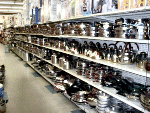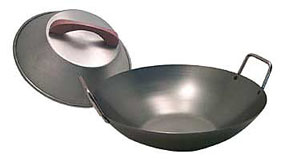 |
 |
|||||
|
||||||
|
|
Choosing A WokArticle excerpt from Kasma Loha-unchit The wok has
survived the centuries and traveled across many continents and oceans into
the kitchens of lands afar. Its roundness, depth and balance make it one
of the most well-designed, versatile and practical cooking utensils of all
time. Though originally designed for pit cooking in China, it is easily
adaptable to various types of stovetops, and people the world over who have
learned to master wok cooking and care, find it hard to replace it with
flat skillets for many kinds of stovetop cooking, from sauteing and stir-frying
to poaching, braising and deep-frying. The wok has
survived the centuries and traveled across many continents and oceans into
the kitchens of lands afar. Its roundness, depth and balance make it one
of the most well-designed, versatile and practical cooking utensils of all
time. Though originally designed for pit cooking in China, it is easily
adaptable to various types of stovetops, and people the world over who have
learned to master wok cooking and care, find it hard to replace it with
flat skillets for many kinds of stovetop cooking, from sauteing and stir-frying
to poaching, braising and deep-frying.
Flat bottom or round bottom, which is better? This is one of the major choice issues with which you are faced. The answer, of course, will depend on the experience and style of cooking of the chef and on the attributes that are most important to him or her. There are pros and cons for each, and therefore, varying preferences and opinions. That is why both types of woks continue to sell well in the markets.
Although the flat bottom wok is specially designed for better balance on flat American stovetops such as the electric stove, it can be a challenge to stir-fry food evenly in it as the flat bottom that sits directly on a coil heats up much hotter than the rounded sides above it. Food can easily burn if it is not tossed quickly enough and tossing is made more difficult for the reason mentioned above. So even on an electric stove, I advise to use a wok ring to lift the wok slightly above the coil. The burners of most electric stoves do put out plenty of heat; even if the wok is slightly lifted from the coils, enough heat will be conducted upward with the proper wok ring for a successful stir-fry. If a wok ring is to be used anyway, then why not stay with the more efficient round bottom wok? There are two kinds of wok rings: one that is made of thick wire with open sides and the other of enclosed metal with small holes for venting. The former is best suited for use on gas burners where flames can leap up the sides of the wok and good air circulation can be maintained for the flames to burn hot, while the latter works well on electric burners as it concentrates and conducts heat upwards. Use both types with the narrower end placed down, so that the wok sits on the wider end. This gives better balance to the wok and brings it closer to the source of heat (but not touching the coil on an electric burner). Seasoning and caring for a wokRinse away the oily factory covering of a new wok before seasoning with cooking oil. Make sure you season the wok well - the same way you would season a cast-iron skillet. Once it is seasoned it will have a wonderful black patina. Never scour a wok, as this will take away your hard-earned seasoning. Never use your wok for steaming, as this will quickly remove the patina. Re-season frequently, as necessary, until a permanent black coating is achieved.Clean only with water and a soft sponge - do not wipe dry but dry instead with heat from the stovetop. If the wok surface appears dried out, re-season quickly before putting it away so that it will not rust. |
|
||||
|
||||||

 The
wok comes in many sizes and is made with many types of materials, from
carbon steel that makes for easy seasoning, to stainless and state-of-the-art
metallic alloys. It comes either with two short, ear-like handles, or
with one long handle and one short one. It also comes in differing depths,
from shallow to well-rounded and deep. But after surviving through the
centuries with its quintessential round bottom, in very recent times,
a flat bottom variety has emerged.
The
wok comes in many sizes and is made with many types of materials, from
carbon steel that makes for easy seasoning, to stainless and state-of-the-art
metallic alloys. It comes either with two short, ear-like handles, or
with one long handle and one short one. It also comes in differing depths,
from shallow to well-rounded and deep. But after surviving through the
centuries with its quintessential round bottom, in very recent times,
a flat bottom variety has emerged.  In
my opinion, there is good reason why the wok has made it down through
the ages with its round bottom and I am not about to compromise away this
most important feature that gives the wok such great versatility. I have
come to this point of view not without first having tried out one of the
flat bottoms. Initially, the flat bottom wok makes great sense to me.
But after using one for a few weeks, I decided it just can't do as many
tricks as my beloved round bottom and ended up swiching back.
In
my opinion, there is good reason why the wok has made it down through
the ages with its round bottom and I am not about to compromise away this
most important feature that gives the wok such great versatility. I have
come to this point of view not without first having tried out one of the
flat bottoms. Initially, the flat bottom wok makes great sense to me.
But after using one for a few weeks, I decided it just can't do as many
tricks as my beloved round bottom and ended up swiching back. Stir-frying
is perhaps the single most important function for which the wok is best
suited. The wide wok spatula has a rounded edge that fits the rounded
contours of the wok, making it a breeze to toss and move about all the
particles of food being cooked in it. When the stir-fry is complete, the
spatula easily dishes out all the pieces of food from the wok surface,
including tiny pieces of chopped garlic. Without any food particles remaining
in the wok, it becomes unnecessary to wash the wok before proceeding with
the next stir-fry, thereby saving precious time in cleaning, drying and
reheating the wok.
Stir-frying
is perhaps the single most important function for which the wok is best
suited. The wide wok spatula has a rounded edge that fits the rounded
contours of the wok, making it a breeze to toss and move about all the
particles of food being cooked in it. When the stir-fry is complete, the
spatula easily dishes out all the pieces of food from the wok surface,
including tiny pieces of chopped garlic. Without any food particles remaining
in the wok, it becomes unnecessary to wash the wok before proceeding with
the next stir-fry, thereby saving precious time in cleaning, drying and
reheating the wok.  With
a flat bottom wok, the introduction of a slight angle where its bottom
flattens out makes tossing with the wok spatula a bit more challenging
and less fun, and often, food is less evenly cooked. Particles of food
caught around this edge sometimes end up overcooking or burning, making
cleanup more of a chore and increasing the likelihood of scrubbing off
some of the precious, hard-earned patina. This slight angle also increases
the likelihood of the wok spatula putting scratches in the area just above
it in an attempt to turn the pieces of food evenly. Some people solve
this problem by replacing the wok spatula with a wooden spoon with which
to stir-fry, but tossing with a wooden spoon is much less efficient than
with the wide wok spatula, and therefore, defeats the purpose of cooking
with a wok.
With
a flat bottom wok, the introduction of a slight angle where its bottom
flattens out makes tossing with the wok spatula a bit more challenging
and less fun, and often, food is less evenly cooked. Particles of food
caught around this edge sometimes end up overcooking or burning, making
cleanup more of a chore and increasing the likelihood of scrubbing off
some of the precious, hard-earned patina. This slight angle also increases
the likelihood of the wok spatula putting scratches in the area just above
it in an attempt to turn the pieces of food evenly. Some people solve
this problem by replacing the wok spatula with a wooden spoon with which
to stir-fry, but tossing with a wooden spoon is much less efficient than
with the wide wok spatula, and therefore, defeats the purpose of cooking
with a wok.  I
have never tryed using an electric wok, so I did some reaserch on the
internet. Most of the information says electric woks are discouraged because
the heat is difficult to control. I have read they are easy to clean.
If you use one and wish to help out here please send me a
I
have never tryed using an electric wok, so I did some reaserch on the
internet. Most of the information says electric woks are discouraged because
the heat is difficult to control. I have read they are easy to clean.
If you use one and wish to help out here please send me a